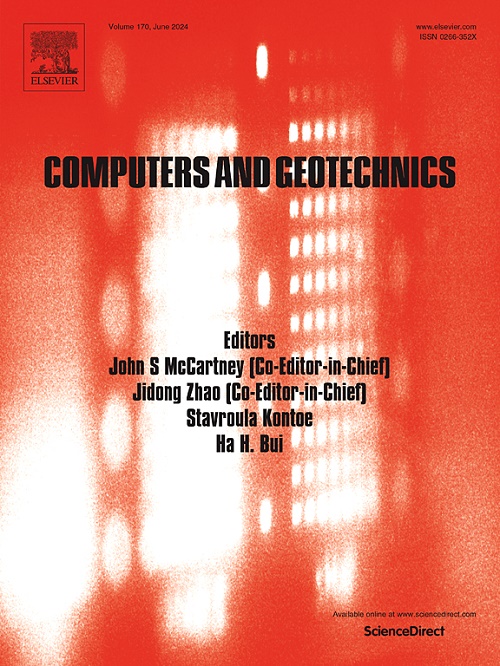用离散元法研究粒径和体积的振动效应及其对滑坡迁移率的影响
IF 6.2
1区 工程技术
Q1 COMPUTER SCIENCE, INTERDISCIPLINARY APPLICATIONS
引用次数: 0
摘要
颗粒剪切振动摩擦弱化是高速、长距离滑坡发生的主要原因。为了揭示滑坡运动过程中剪切振动摩擦减弱的机理,采用离散元法(DEM)建立了水槽模拟模型,研究了体积和粒径对颗粒振动、基底应力和颗粒流动性的影响。随着体积的增大,基底振动(应力)的主频和咏叹调强度增大。粒径与基振咏调强度呈正相关,与主振频率呈负相关。平均基底正应力的演化趋势表现为上升、缓慢衰减和快速衰减三个阶段。平均基底法向应力和基底波动应力均与体积呈正相关。粒径的增大不仅延缓了平均基底法向应力峰值的出现,而且促进了基底波动应力的增大。颗粒的体积和粒度对其流动性有显著影响。体积和粒径的增大会导致颗粒流的有效摩擦系数和表观粘度的减小;颗粒流的速度分布呈现从上到下递减的非线性分布,速度梯度也随着体积和粒径的增大而增大。本文章由计算机程序翻译,如有差异,请以英文原文为准。
Vibration effects of particle size and volume and their influence on landslide mobility via the discrete element method
Particle shear vibration frictional weakening is a major cause of high-speed and long-distance landslides. To reveal the mechanism of shear vibration frictional weakening during landslide movements, a flume simulation model was established using the discrete element method (DEM), and the effects of volume and particle size on particle vibration, basal stress and particle fluidity were studied. With increasing volume, the Arias intensity and dominant frequency of the basal vibration (stress) increase. However, the particle size is positively correlated with the Arias intensity of the basal vibration and is negatively correlated with the dominant frequency. The evolution trend of the average basal normal stress exhibited three stages: rising, slow decay and rapid decay. Both the average basal normal stress and the basal fluctuating stress are positively correlated with volume. An increase in particle size not only delays the occurrence of the average basal normal stress peak but also promotes an increase in the basal fluctuation stress. The volume and particle size of a particle significantly affect its fluidity. An increase in volume and particle size will lead to a decrease in the effective friction coefficient and apparent viscosity of the particle flow; the velocity profile of the particle flow will exhibit a nonlinear distribution of decreases from top to bottom, and the velocity gradient will also increase with increasing volume and particle size.
求助全文
通过发布文献求助,成功后即可免费获取论文全文。
去求助
来源期刊

Computers and Geotechnics
地学-地球科学综合
CiteScore
9.10
自引率
15.10%
发文量
438
审稿时长
45 days
期刊介绍:
The use of computers is firmly established in geotechnical engineering and continues to grow rapidly in both engineering practice and academe. The development of advanced numerical techniques and constitutive modeling, in conjunction with rapid developments in computer hardware, enables problems to be tackled that were unthinkable even a few years ago. Computers and Geotechnics provides an up-to-date reference for engineers and researchers engaged in computer aided analysis and research in geotechnical engineering. The journal is intended for an expeditious dissemination of advanced computer applications across a broad range of geotechnical topics. Contributions on advances in numerical algorithms, computer implementation of new constitutive models and probabilistic methods are especially encouraged.
 求助内容:
求助内容: 应助结果提醒方式:
应助结果提醒方式:


